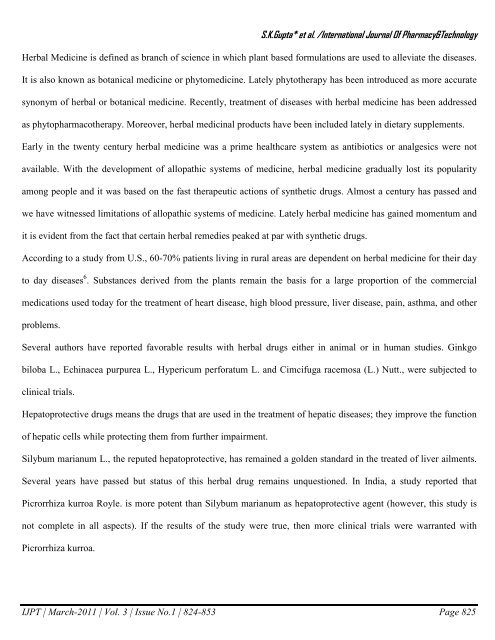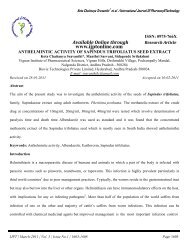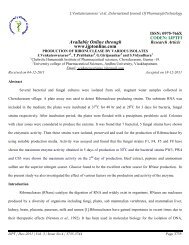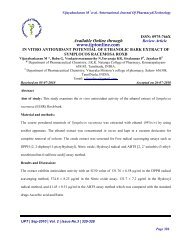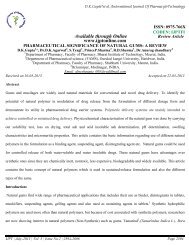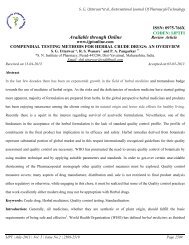SK Gupta* et al. /International Journal Of Pharmacy&Technology
SK Gupta* et al. /International Journal Of Pharmacy&Technology
SK Gupta* et al. /International Journal Of Pharmacy&Technology
- No tags were found...
Create successful ePaper yourself
Turn your PDF publications into a flip-book with our unique Google optimized e-Paper software.
S.K.<strong>Gupta*</strong> <strong>et</strong> <strong>al</strong>. /Internation<strong>al</strong> Journ<strong>al</strong> <strong>Of</strong> Pharmacy&<strong>Technology</strong>Herb<strong>al</strong> Medicine is defined as branch of science in which plant based formulations are used to <strong>al</strong>leviate the diseases.It is <strong>al</strong>so known as botanic<strong>al</strong> medicine or phytomedicine. Lately phytotherapy has been introduced as more accuratesynonym of herb<strong>al</strong> or botanic<strong>al</strong> medicine. Recently, treatment of diseases with herb<strong>al</strong> medicine has been addressedas phytopharmacotherapy. Moreover, herb<strong>al</strong> medicin<strong>al</strong> products have been included lately in di<strong>et</strong>ary supplements.Early in the twenty century herb<strong>al</strong> medicine was a prime he<strong>al</strong>thcare system as antibiotics or an<strong>al</strong>gesics were notavailable. With the development of <strong>al</strong>lopathic systems of medicine, herb<strong>al</strong> medicine gradu<strong>al</strong>ly lost its popularityamong people and it was based on the fast therapeutic actions of synth<strong>et</strong>ic drugs. Almost a century has passed andwe have witnessed limitations of <strong>al</strong>lopathic systems of medicine. Lately herb<strong>al</strong> medicine has gained momentum andit is evident from the fact that certain herb<strong>al</strong> remedies peaked at par with synth<strong>et</strong>ic drugs.According to a study from U.S., 60-70% patients living in rur<strong>al</strong> areas are dependent on herb<strong>al</strong> medicine for their dayto day diseases 6 . Substances derived from the plants remain the basis for a large proportion of the commerci<strong>al</strong>medications used today for the treatment of heart disease, high blood pressure, liver disease, pain, asthma, and otherproblems.Sever<strong>al</strong> authors have reported favorable results with herb<strong>al</strong> drugs either in anim<strong>al</strong> or in human studies. Ginkgobiloba L., Echinacea purpurea L., Hypericum perforatum L. and Cimcifuga racemosa (L.) Nutt., were subjected toclinic<strong>al</strong> tri<strong>al</strong>s.Hepatoprotective drugs means the drugs that are used in the treatment of hepatic diseases; they improve the functionof hepatic cells while protecting them from further impairment.Silybum marianum L., the reputed hepatoprotective, has remained a golden standard in the treated of liver ailments.Sever<strong>al</strong> years have passed but status of this herb<strong>al</strong> drug remains unquestioned. In India, a study reported thatPicrorrhiza kurroa Royle. is more potent than Silybum marianum as hepatoprotective agent (however, this study isnot compl<strong>et</strong>e in <strong>al</strong>l aspects). If the results of the study were true, then more clinic<strong>al</strong> tri<strong>al</strong>s were warranted withPicrorrhiza kurroa.IJPT | March-2011 | Vol. 3 | Issue No.1 | 824-853 Page 825


